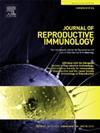Earlier pregnancies in nulliparous women with current father and lower risks for preeclampsia and low-birth weight newborns
IF 2.9
3区 医学
Q3 IMMUNOLOGY
引用次数: 0
Abstract
New paternity has been related to placenta-associated complications in pregnancy. We evaluated whether a lack of earlier pregnancies or deliveries with a current father are associated with the pregnancy, prenatal, and early neonatal outcomes after controlling for the most common maternal confounders in prospective birth cohort study. An online questionnaire was used to survey 4459 pregnant women from the Kuopio Birth Cohort in their third trimester. The topics included their history of paternity in current and earlier pregnancies. Data were combined with prenatal, perinatal, and early neonatal information. A multivariable logistic regression analysis was performed to compare the possible associations between selected pregnancy and early neonatal outcomes with respect to paternal change. Pregnant women with changed partners had higher rates of smoking during pregnancy and hypertension before pregnancy. In the adjusted analysis, primigravidas and nulliparous multigravidas with different father had the highest risks for preeclampsia (adjusted odds ratios (aORs) 4.46 and 2.69, respectively), low birth weight (aORs 3.15 and 2.25), and smallness for gestational age (aORs 2.23 and 2.16) compared to the parous controls. Nulliparous women who had earlier pregnancies with the current father had less preeclampsia or gestational hypertension, as well as low birth weight (aOR 0.42, 95 % confidence interval (CI) 0.21–0.82 and aOR 0.26, 95 % CI 0.08–0.87, respectively) compared to other nulliparas. Among parous women, most of the pregnancy, obstetric, and early neonatal outcomes were similar in the adjusted analysis, regardless of new changes in paternity.
求助全文
约1分钟内获得全文
求助全文
来源期刊
CiteScore
6.30
自引率
5.90%
发文量
162
审稿时长
10.6 weeks
期刊介绍:
Affiliated with the European Society of Reproductive Immunology and with the International Society for Immunology of Reproduction
The aim of the Journal of Reproductive Immunology is to provide the critical forum for the dissemination of results from high quality research in all aspects of experimental, animal and clinical reproductive immunobiology.
This encompasses normal and pathological processes of:
* Male and Female Reproductive Tracts
* Gametogenesis and Embryogenesis
* Implantation and Placental Development
* Gestation and Parturition
* Mammary Gland and Lactation.

 求助内容:
求助内容: 应助结果提醒方式:
应助结果提醒方式:


